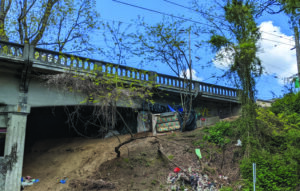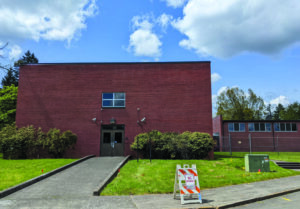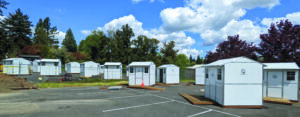

Over the last decade, while three quadrants—Northeast, Northwest, and Southeast–of the City of Portland became sorely inflicted with the scourge of homelessness, Southwest Portland, particularly the Far Southwest districts, remained largely immune.
That is changing. A particularly debased encampment has sprung up under the SW Barbur Blvd. overpass at the Multnomah Village exit. Lodged on a steep slope, a slip from which would cause serious injury, perhaps death, filthy blankets hang from the bridgework, and a maelstrom of garbage cascades down onto the exit ramp from a habitation that can only be described as appalling.
It is not the kind of welcome to the Village that the reliably progressive residents around these parts can be happy about, despite their propensity to keep electing politicians who Independent gubernatorial candidate Betsy Johnson describes as having “turned the City of Roses into the City of Roaches.”

But it isn’t just the unfortunate mentally ill and lost souls of drug addiction that are bringing homelessness to the wealthiest per capita part of Portland; the city’s decisionmakers, in attempting to redress the problem, have provided for the construction of a tiny-house “Safe Rest Village”-within-the-Village. Just a short drive down Multnomah Blvd. from the overpass encampment, 30 so-called “pods” are under construction, which officials say can house up to 60 people.
A vehement contingent of Village residents fought having the facility located in the parking lot of the old Sears Armory and lost. The track record for homeless individuals at the location was not good; in 2016, when then-Mayor Charlie Hales designated the armory building as a temporary winter shelter for women on the streets, tales emerged of late-night homeless revelry, loud arguments, petty thefts in the neighborhood, prostitution, and open drug usage.
What is purportedly different about the new Safe Rest Village is that officials are vowing to provide 24-hour professional onsite oversight and services, which they say will keep the residents in line, and prevent the kind of disruption and predation that caused even the reliably progressive Multnomah Village Neighborhood Association to adamantly oppose the plan.

They worry that although the facility itself may be managed, the overflow homeless that may be drawn to Safe Rest Village will degrade the area, as other metro areas have been demonstrably degraded by the influx of homelessness.

All eyes in the relatively insulated neighborhood of Multnomah Village will be on the facility, which—as of the NWC June deadline, hoped to begin taking applications in May. The Village is an almost surreally quiet, generally law-abiding, and neighborly district, (as are most of the Far Southwest Portland districts.) For the most part, the streets are free of rubbish, and residential properties are well-maintained. It has been customary for parents to allow their older children and grandchildren to go down to the Village retail strip and visit the candy stores, boutiques, and Thinker Toys location without the justifiable fears that beset responsible adults in other areas of the city.
Many in this sheltered, single-family residential area fear that when formerly homeless people who may be drug-addicted or mentally ill began roaming the streets, those halcyon days will come to an end.
Estimates vary on the number of homeless in Portland, but a recent federally- mandate Point-In-Time survey conducted by the Joint Office of Homeless Services found that just over 5,200 people are homeless on Portland’s streets.
Doing the math at an average of 60 residents per Safe Rest Village equates to the need for 86 such villages to fully house the city’s homeless population. Many, perhaps most of the homeless, due to drug addiction and mental illnesses, would resist even such a humane alternative to the streets.
It is dawning on Portlanders who come from all points on the political spectrum that the solvation of this social scourge may be out of reach. Just the garbage and rubbish clean-up alone would represent a Herculean civic task.
The only real solution to the problem—forced resettlement of the chronic homeless to fenced-in tent camps which provide for basic needs and addiction and mental health counseling—is patently unconstitutional.
No Comments
Leave a comment Cancel